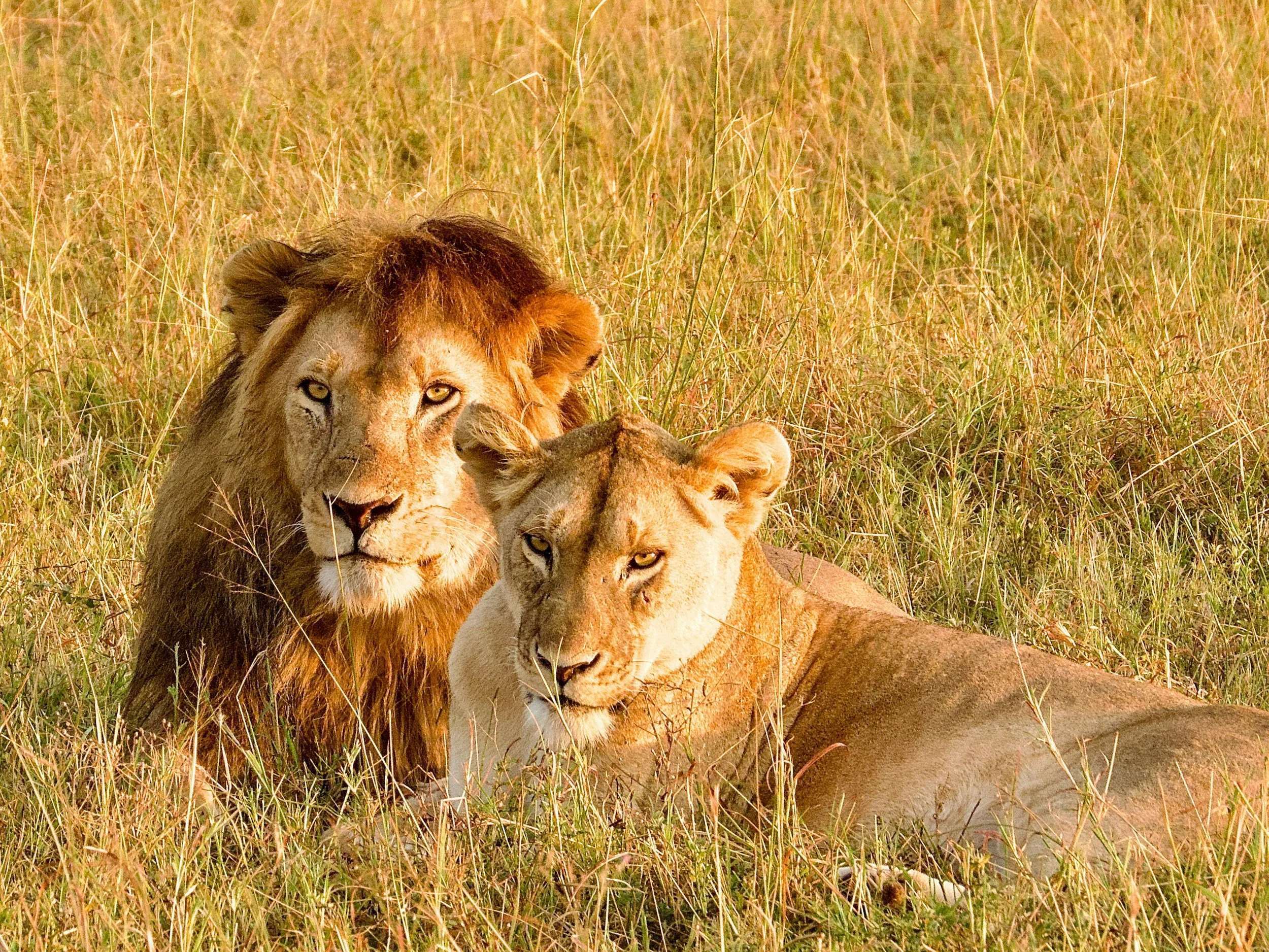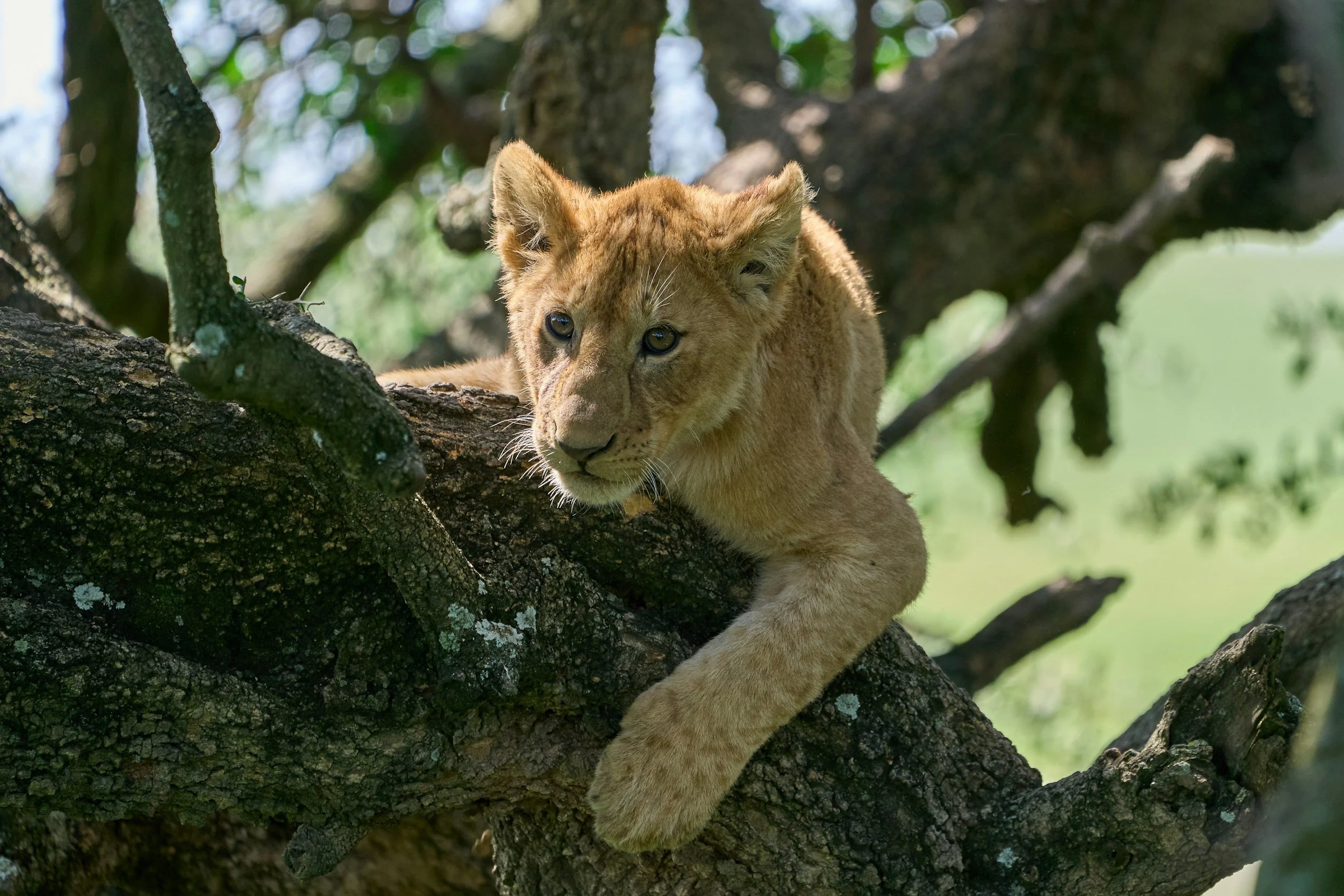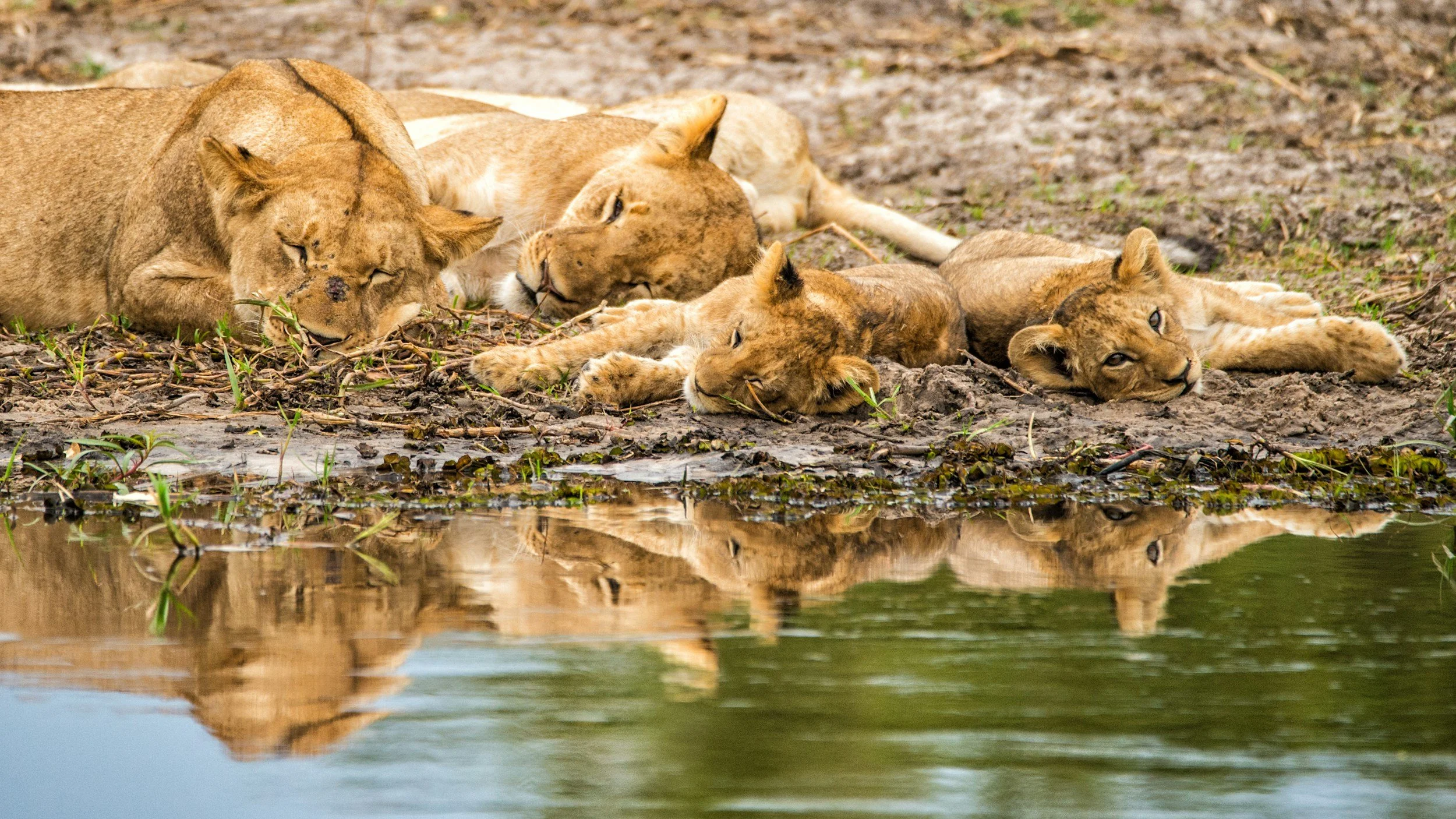YOUR COMPLETE SERENGETI LION HANDBOOK
A Serengeti lioness in amongst the bush looking out. The Serengeti is home to over 3,000 lions which makes for incredible viewing opportunities / Image: @dmitrii_zhodzishskii
If there’s one animal that steals the spotlight in Tanzania, it’s undoubtedly the lion. And where better to encounter the world’s largest population of these magnificent creatures than in the Serengeti? For wildlife enthusiasts, spotting the Serengeti lions isn’t just a goal; it’s a dream come true.
These incredible big cats encompass the raw beauty that the Serengeti is known for. Imagine hearing their mighty roars echoing across the plains or catching sight of the awe-inspiring 'Super Pride' as they move together in their display of unity. They really are the heartbeat of the northern Tanzanian savannahs, where thousands of the majestic cats roam freely, dominating what they view as their kingdom.
This is your complete Serengeti lion handbook for discovering these powerful beasts of the wild.
Magical 1-Day Ngorongoro Crater Tour
Experience a spectacular taste of Tanzania in our unforgettable 1-Day safari experience within the breath-taking Ngorongoro Crater
TABLE OF CONTENTS
Two Serengeti lions taking a well deserved rest near a water source within the park. During the day lions tend to be much less active than at night.
Quick Facts About the Lions of the Serengeti
They Love to Socialise
Lions are known for their social nature. If you are able to join us on our African lion safaris, you'll notice they travel in groups rather than by themselves. Unlike other big cats, who prefer smaller circles or being alone, the lions of the Serengeti thrive when they're moving in their tight-knit prides. Usually, these prides are made up of anywhere between 3 to 20 members, with males leading the pack alongside females and a combination of adolescent members and cubs.
The Females Shoulder the Hunting Responsibility
The females take on the hunting duties among lions. Males may join the kill but typically tend to watch from afar, it’s the females who lead the charge. They like to hunt for wildebeest and zebras, especially during the Great Migration in the Serengeti which is due to the high condensed numbers of animals providing much easier kills. However, buffalo and warthogs are also species, lions like to eat too.
Spotting lions on a daytime hunt isn't common, as lions prefer to hunt nocturnally when they’re less likely to be seen. You might wonder how they manage to hunt in the dark; well, their eyes have what is known as ‘rod cells’ in their retinas which help them to see much easier in low light. It's worth noting that they also love hunting when the weather is stormy, as the thunder masks their movements, giving them the perfect opportunity to ambush their prey.
A potential kill in action! A lioness chooses her prey before pouncing / Image: @chuklanov
They Express Themselves in Their Own Special Way
One of the most unique things about lions is how they express themselves. We often associate loud roars with lions, but this is only one of the ways they communicate. Besides howling, they also grunt, growl, poor, woof, and puff. In some cases, lions can be heard up to nearly 5 miles in the distance, whether to notify their pride members that they're close, communicate or to scare away other prides.
A lioness enjoys her fresh kill. If you are lucky you may get to witness a lion kill in action / Image: @lebalu
Most of Their Day Is Spent Sleeping
Lions love to sleep. You’ll most likely find them relaxing with their pride on your Serengeti Safari. While each lion is unique, it’s estimated they can sleep around 20 hours a day, some even more.
Their lack of sweat glands helps them conserve energy while they sleep throughout the day. This enables them to to hunt more actively throughout the night when temperatures have dropped.
A lioness and her cub at a fresh buffalo kill. Male lions get to feast first, followed by the female lionesses and lastly the cubs / Image: @cdm3302
How Many Lions Are in the Serengeti?
Estimating how many lions are in the Serengeti can be difficult as quite a few factors influence the total figures, but it's believed there are around 3,000 - 4,000 in total. The difficulty in determining precise numbers is mainly due to the elements that cause lions to migrate to other locations.
For instance, if prey becomes scarce in the Serengeti after the Great Migration ends for the year, the lions will need to venture elsewhere in search of food to survive. Additionally, rivalries with other prides play a significant role, as increased competition for food can drive the lions to look in other places for better hunting opportunities.
How many lion prides are in the Serengeti?
It is believed that there are approximately 300 different lion prides within the Serengeti. This number can fluctuate due to many factors, some being the environment, how humans are having an effect on lions, food availablity as well as competition with other prides and pride members.
Normally, the average pride has two dominant males, four females and two cubs but this number can vary highly within the Serengeti range. Some prides can have as little as 3 pride members up to around 40 members.
What do lions eat in the Serengeti?
When it's time to feast, lions can eat a large amount of food per sitting. Even though they only tend to eat every three to four days, the portions are generous when they do. In one serving, they are capable of consuming around 40 kg of meat, which equals to about a quarter of the size of their body.
Watching how they eat is impressive; every last morsel of meat is scraped off the bones of a carcas with the razor-edge papillae on their tongues, which act almost like a knife for them.
Small lion prides to super prides - you will get to experience it all in the Serengeti / Image: @jp_shot_
Do lions follow the Great Migration?
The Great Migration is one of the biggest spectacles you can witness throughout the Serengeti National Park during the months of June to October. Zebras, gazelles and wildebeest are the most common animals taking part in this annual journey, however lions play a big part in the Great Migration too.
The Serengeti lions utelize the Great Migration as a way to rely on the wealth of prey galloping before them, making them one of the migrations key predators. Using strategic hunting tactics as well as their powerful social structure of pride members, they close in on species as they cross the vast open plains and the dangerous rivers. The alpha lionesses of the pride work together to encroach on their chosen prey using precise coordination skills, which is hugely important to the success of the kill. The drama of the migrating herds and preying lions coming to collision is a rare highlight to observe when watching the Great Migration unfold.
What is the Maasai perspective on the Serengeti lions?
Its no secret that the Maasai people have always had a challenging relationship with the lions who live alongside them. In the past, the Maasai culture saw lions as a symbol of strength and courage. The traditional practice for young warriors was to hunt lion in order to prove their bravery and masculinity as a rite of passage into adulthood.
However, as lion conservation evolves and numbers of lion numbers at a breathtaking low, the Maasai people have shifted their mindsets and adopted new methods. The Maasai communities now work alongside recognized lion organizations to not only protect lions but also to coexist in harmony together as well as keep their livestock safe from lion attacks. There are many methods they use, including lion-proof enclosures for their cattle, learning why the serengeti lions are so important to their thriving eco-system and why its so important in protecting them for future generations to come.
What do the Maasai people think of the lions of the Serengeti and how do they live alongside them in harmony? / @szubiria
About Lion Prides
What sets lions apart from other big cats is how they form tight-knit groups which are called 'prides.' These prides include both males and females, who typically do most activities together. Whether they’re sleeping or eating, nearly every moment is shared. It’s not just a collection of lions; it's a family with a powerful social structure that the dominant males enforce.
Let's take a closer look at the lion pride structure:
1- 4 Male Leading Dominating Characters
The dominant males are the pride’s guiding force with usually one to four of them taking full control. While they don’t do as much hunting as the lionesses, their role is to protect their pride and maintain protection over their territory.
Usually the Male lions of the prides are closely related; which enables a strong bond from the outset.
Less or More Than Twelve Lionesses
Commonly, a pride will include around two to twelve lionesses, though it can vary. These lionesses are the backbone of the pride, made up of mothers, daughters, and sisters who hunt and nurture the cubs. As you can imagine, a strong maternal instinct is ingrained in them from a young age. The responsibility of raising their cubs to make sure the ongoing generation is strong and capable is of high importance.
Cubs
The cubs of the pride are raised mainly by the female lionesses, however, the collective pride all have their seperate roles in nurturing the cubs for the future.
Interestingly, a cub’s upbringing is centered on preparing it for survival, but they leave the pride around the age of three. Oftentimes, they’re driven out by rival males or choose to leave by themselves to take over an existing pride or start a new one.
Cub sightings are seen all year round in the Serengeti - here are four members of a pride relaxing by a water source / Image: @bist31
‘Super Prides’ of the Serengeti Explained
Super prides are very rare not just in the Serengeti but around the world. The term 'super pride' has been given to groups of lions that have more than 20 members led by the dominant males.
One of the key benefits of super prides is that they have strength in numbers compared to smaller groups. This allows them to compete easily with others over prey and have a higher chance of asserting their dominance in territories.
Unfortunately, you may not come across many super prides in the Serengeti, but they do exist.
Super pride dynamics are different compared to others, which means because of the higher number of pride members they'll hunt more frequently than smaller groups; this tends to be around every 2 to 3 days. This also affords them the opportunity to be able to hunt for larger animals like elands and buffalo because they have a stronger pack when taking down a kill.
Unfortunately, the downside of having more lions in a pride is additional competition for superiority. When the cubs start maturing and learn how to express their strength, this can sometimes be a threat to the existing dominant males. At times, the younger cubs may take it upon themselves to assert their dominance, which can cause a rift within the super pride.
The Serengeti lions consist of many ‘Super Prides’. These prides are less common to spot but if you are fortunate, you may get to see one / Image: @bist31
The Full Picture of the Serengeti Lions
The lions in the Serengeti are undoubtedly some of the park’s most fascinating residents. From their complex pride structure to their unique daily routines, they’re wonderfuly interesting creatures to observe.
If there’s one place where you absolutely must experience the lions in Tanzania, it’s the Serengeti. With the largest lion population in the world calling this place home, it gives you the best chances to see these majestic creatures in their natural habitat. Plus, BornWild offers plenty of tours to help you do just that.
Join us on our incredible 4-day Serengeti Adventure
Our 4-Day Serengeti Safari offers a jam-packed, unforgettable mini adventure, featuring a variety of incredible highlights along the way.
Explore the mesmerising central and northern regions of the Serengeti, where we will experience its vast stunning landscapes as well as its spectacular wild species. Watch the awe-inspiring spectacle of the Great Migration, the marvelous calving season, journey through its diverse natural wilderness and immerse yourself in Africa’s most famous national park, experiencing the Serengeti to its fullest.












